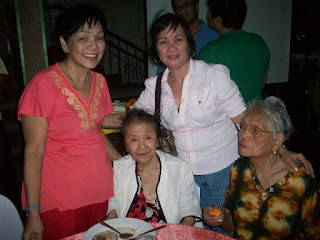And when is the best time we, Pinoys, do the emoting?
Let's eliminate the feelings while watching soap operas, and go down to the basics.

When it comes to singing, Pinoys would grab the microphone at karaoke parties, and sing to their lungs' delight. Bigay todo at full expression, ika nga. (Full of gusto and feelings).
When it comes to expressing their love, Pinoys would emote top of the line. Whoever started the harana, (moonlight serenade) anyway? If yesterday, our grandfathers strummed their guitars to our grandmathers' hearts, today's Pinoy Casanova or Bella would exchange playlists with the object of their desire.
The palengkera-style (below the belt) of quarelling with the loved one, with the neighbour, with the in laws or rotten friends and pasaway na mga tao , is another venue for Pinoy emoting. Colorful oral and body languages are utilized in such scenarios. May sabunutan, may finger pointing, may murahan, may umbagan.
With the increasing popularity of social networking and digital communication (wireless, cell phones, etc), Pinoys have been a solid bloc in venting their anger, appreciation, angst, adoration, acrimony and adulation. Be it in politics, showbiz, rumor mongering, and other issues, Pinoys would not forget to add the trademark Pinoy humour or joke - another form of Pinoy emoting. Magaling magpatawa at madali ring mapikon.
################################################
Sample below of Pinoy humour.
ERAP JOKES
(Para sa mga Pinoys)
Classmate 1: What is 5 plus 4?
Erap: Eh di 9!
Classmate 2: What is 4 plus 5?
Erap: Gagaguhin mo pa ako eh binaligtad mo lang... eh di 6! #################################################
And when Pinoys get married, the emoting can burst at the seams. Parents of both bride and groom would both cry out of joy or gloom, and the wedded couples would even resort to gimmicks to celebrate their unions, such as elaborate themes, and out-of-church practises.
But one area where Pinoys are unbeatable is in time of sickness and death. We express our sorrow, pain and loss by visiting the sick, lending support to his/her family, attending the wake and funeral. Even in Mang Dolphy's wake, one could see the "emoting" even of celebrities and ordinary people.
In the average Pinoy household, relatives come together or even have reunions when a family member dies. In some wakes, family members settle their scores with one another, at times becoming destructive, while others make the wake a staging area to upstage friends and family. May naghahalukay ng lumang isyu sa familia, may nagmamayabang. There are even people who'd scream, "sasama na ako sa'yo sa hukay." But deep in the heart, Pinoys are really cry babies, mababaw ang luha.

The most disheartening kind of emoting is when family members forget their manners, duties, responsibilities and simple ethics. Couples leave one another, children disrespect and disown their parents, and members forget the good deeds and only remember the bad ones.
 | ||
| In Memoriam - RITA DESIDERIO- seated in white blazer |
May 1928 - Oct. 7, 2012
MAY SHE REST IN PERPETUAL PEACE.
They say that Pinoys are prayerful. And this is where emoting is best. Pinoys sing during the mass and service, and observe many practises and rituals. In the Philippine Catholic tradition, there is the pabasa ng pasyon, the Santa Cruzan, the countless novenas, devotion or the panata, among many other practises.


1 comment:
Thanks for your nice experience to share with us. Really awesome article with plenty of informative things to be known for us.
Post a Comment